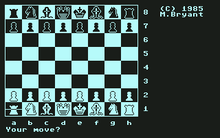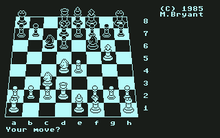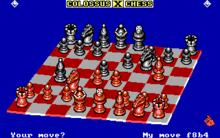Colossus Chess
Colossus Chess is a series of chess-playing computer programs developed by Martin Bryant, commercially available for various home computers in the 1980s.
| Colossus Chess | |
|---|---|
 C64 Box art | |
| Developer(s) | Martin Bryant |
| Publisher(s) | CDS Micro Systems English Software |
| Platform(s) | Acorn Electron,[1] Amiga,[2] Amstrad CPC,[3] Amstrad PCW,[4] Apple II,[4] Atari 8-bit,[5] Atari ST,[6] BBC Micro,[7] Commodore 64,[8][9] Commodore Plus/4,[10][11] Enterprise 64 & 128,[12] IBM PC,[13] MSX,[14] ZX Spectrum[15][16] |
| Release | 1984–1990 (Colossus Chess) 2006–2008 (Colossus Chess UCI) |
| Genre(s) | Chess |
| Mode(s) | Single-player |
History


Bryant started Colossus Chess in 1983, using his White Knight Mk 11 program,[4] winner of the 1983 European Microcomputer Chess Championship,[17] as a basis. It was developed on an Apple II, but was first commercially released for Commodore 64 as Colossus Chess 2.0 (CDS Micro Systems, 1984). A number of releases for 8-bit microcomputers followed. Version 3.0 was released in 1984 for the Atari 8-bit family of computers (published by English Software), followed by 4.0 in 1985 which was released on most formats of the day (published by CDS). Per other games of the time, the Acorn Electron implementation required that part of the screen memory be used as working space.[18]
Colossus Chess featured time-controlled play with game clocks, an opening book with 3,000 positions, and problem-solving mode that could solve normal mates, selfmates and helpmates.[19] Pondering on opponent's time and a three-dimensional chessboard were introduced in Colossus Chess 4.0. All releases were written in the assembly language of the appropriate CPU;[4] the ZX Spectrum version could examine an average of 170 positions per second.[19]
Uncommon for microcomputer chess programs of the era, Colossus had a full implementation of the rules of chess, including underpromotion, the fifty-move rule, draw by repetition, and draw by insufficient material.[19] Colossus was also able to execute all the basic checkmates, including the difficult bishop and knight checkmate.[19]
Colossus Chess X

The program was subsequently ported to Atari ST (1988), Amiga (1989) and IBM PC (1990) under the title Colossus Chess X. The new releases featured four chess sets[20] and enhanced graphics developed with the assistance of Gary Thomlinson and Carl Cropley.[4] The opening book was extended to 11,000 positions, and the program had the ability to learn from past playing experiences.[20]
UCI version
No work was done on Colossus Chess from 1991 to 2005, when Martin Bryant created a completely new and freely available Windows version conforming to the Universal Chess Interface.[21] It was written in C#, then converted to C for speed, and was finally publicly released in 2006.[21] As of January 2009, the latest version is 2008b.[21]
Reception
Info gave Colossus Chess IV for the Commodore 64 three stars out of five, stating that it was less attractive but "a darn sight more playable" than Chessmaster 2000 with both keyboard and joystick controls. The magazine warned of the difficulty of remembering the "shifted keyboard control sequences ... badly in need of a quick-reference card".[22]
References
- "Colossus 4.0 for Acorn Electron - X Game Database". www.xgd.com. Archived from the original on 2011-07-17. Retrieved 2008-06-14.
- "Colossus Chess X for Commodore Amiga - X Game Database". www.xgd.com. Archived from the original on 2011-07-17. Retrieved 2008-06-14.
- "Collosus 4 Chess by CDS for the Amstrad CPC". www.cpczone.net. Retrieved 2008-06-15.
- Bryant, Martin. "Colossus Chess". Archived from the original on 2013-11-24. Retrieved 2008-05-22.
- "Atarimania - Atari 400, 800, XL, XE - Colossus Chess 3.0". www.atarimania.com. Retrieved 2008-06-15.
- Higham,Mark;(Dec 1988);Battlechess vs Colossus Chess X in ST Amiga FormatIssue 6;pp. 66
- "Colossus 4.0 - Chess for Acorn BBC Micro - X Game Database". www.xgd.com. Archived from the original on 2011-07-17. Retrieved 2008-06-14.
- "Colossus Chess 2.0". www.lemon64.com. Retrieved 2008-07-07.
- "Colossus Chess 4.0". www.lemon64.com. Retrieved 2008-07-07.
- "Colossuss Chess +4 - Software Details - Plus/4 World". plus4.emucamp.com. Archived from the original on 2008-03-13. Retrieved 2008-06-15.
- "Colossus 4 Chess for Commodore C16, C116 & Plus-4 - X Game Database". www.xgd.com. Archived from the original on 2011-07-17. Retrieved 2008-06-14.
- "Colossus Chess 4 for Enterprise 64 & 128 - X Game Database". www.xgd.com. Archived from the original on 2011-07-17. Retrieved 2008-06-14.
- Ponting,Tim;(Sep 1990);Colossus Chess X review in Zero 11;pp60-61
- "Colossus 4 Chess (1986, CDS Micro Systems)". www.generation-msx.nl. Retrieved 2008-06-15.
- "Colossus 4 Chess". www.worldofspectrum.org. Retrieved 2008-06-15.
- "Colossus 4 Chess for Sinclair ZX Spectrum - X Game Database". www.xgd.com. Archived from the original on 2011-07-17. Retrieved 2008-06-14.
- Bryant, Martin. "White Knight". Archived from the original on 2015-03-17. Retrieved 2008-05-22.
- Bernard Hill (March 1987). "New Chess grandmaster for the Beeb? (Colossus 4 review)". Beebug. 5 (9): 12.
The manual indicates that the program version which loads in to a Model B or Electron is different to that for the Master or B+, and the board display shows this very clearly. The 32k program displays less than a full mode 4 screen as the program loads right up to %6040 [Mode 4's screen memory starts at %5800]
- Colossus Chess 4 for Sinclair ZX Spectrum. CDS Software. Retrieved 2008-06-02. (product manual)
- "More from Artworx". ST-Log (35): 11. August 1989. Retrieved 2008-06-10.
- Bryant, Martin. "Colossus Chess UCI". Archived from the original on 19 March 2016. Retrieved 2009-01-18.
- Dunnington, Benn; Brown, Mark R.; Malcolm, Tom (January–February 1987). "64/128 Gallery". Info. pp. 14–21.
External links
- Colossus home page
- Colossus Chess at MobyGames
- Colossus Chess 2.0 at Lemon 64
- Colossus Chess 4.0 at Lemon 64
- Colossus Chess 4.0 at SpectrumComputing.co.uk
- "Colossus Chess 4.0". Zzap!64 (8). December 1985.
- Colossus Chess 4.0 product manual (C64)